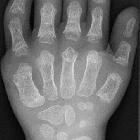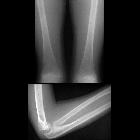cone shaped epiphyses

Ellis–van
Creveld syndrome, X-ray left hand with ossification abnormalities os hamatum, cone-shaped epiphyses

Schema einer
zapfenförmigen Epiphyse der Basis der Mittelphalanx D5 (rot) bei normalen Epiphysen der Basen der End- und Grundphalanx. Zapfenepiphysen an den Phalangealknochen kommen bei zahlreichen Skeletterkrankungen wie Achondroplasie, Sichelzellanämie und weiteren vor, aber auch als Normvariante bei ansonsten gesunden Menschen. Links frontale Ansicht, rechts seitlich.

Extending the
spectrum of Ellis van Creveld syndrome: a large family with a mild mutation in the EVCgene. Radiographs of patient IV-9. A) Coned epiphysis of the left second middle phalanx and prominent styloid process of the ulna B) Irregular notched tip of the distal phalanx of the hallux C) Bowing of the right humerus D) Fusion of the right proximal tibia and fibula.
A useful mnemonic for remembering the causes of cone-shaped epiphysis is:
- ABCDE MOST
Mnemonic
- A: achondroplasia, acrodysostosis
- B: Beckwith-Wiedemann syndrome
- C: chondroplasia punctata, Cockayne syndrome, conorenal syndrome, cleidocranial dysplasia, cartilage-hair hypoplasia
- D: dactylitis, Dyggve-Melchior-Clausen syndrome
- E: Ellis van Creveld syndrome
- M: multiple epiphyseal dysplasia, metabolic (hyperthyroidism)
- O: osteomyelitis
- S: sickle cell disease
- T: thermal injury (burns, frostbite), trichorhinophalangeal syndrome
Siehe auch:
- Osteogenesis imperfecta
- Kleidokraniale Dysplasie
- Achondroplasie
- Ellis-van-Creveld-Syndrom
- asphyxierende Thoraxdysplasie (Jeune-Syndrom)
- Skorbut
- Pseudohypoparathyreoidismus
- Tricho-rhino-phalangeale Dysplasie
- Muenke-Syndrom
- Weill-Marchesani-Syndrom
- Saldino-Mainzer-Syndrom
- acrodysplasis with retinitis pigmentosa and nephropathy
- Akrodysostose
- angel-shaped phalangoepiphyseal dysplasia
- vitamin A intoxication
- radiation injury
- Fitzsimmons-Guilbert-Syndrom

 Assoziationen und Differentialdiagnosen zu zapfenförmige Epiphyse:
Assoziationen und Differentialdiagnosen zu zapfenförmige Epiphyse:






